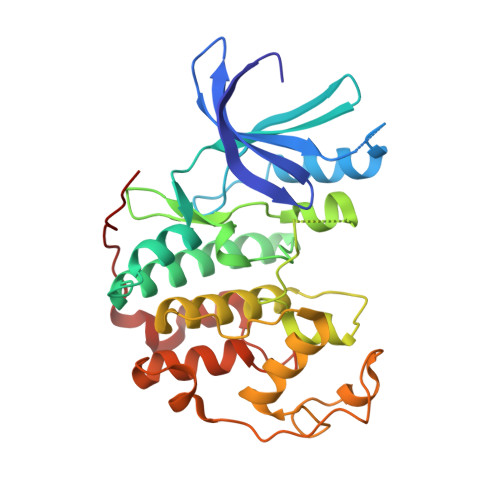Conformational Adaption May Explain the Slow Dissociation Kinetics of Roniciclib (BAY 1000394), a Type I CDK Inhibitor with Kinetic Selectivity for CDK2 and CDK9.
Ayaz, P., Andres, D., Kwiatkowski, D.A., Kolbe, C.C., Lienau, P., Siemeister, G., Lucking, U., Stegmann, C.M.(2016) ACS Chem Biol 11: 1710-1719
- PubMed: 27090615
- DOI: https://doi.org/10.1021/acschembio.6b00074
- Primary Citation of Related Structures:
5IEV, 5IEX, 5IEY, 5IF1 - PubMed Abstract:
Roniciclib (BAY 1000394) is a type I pan-CDK (cyclin-dependent kinase) inhibitor which has revealed potent efficacy in xenograft cancer models. Here, we show that roniciclib displays prolonged residence times on CDK2 and CDK9, whereas residence times on other CDKs are transient, thus giving rise to a kinetic selectivity of roniciclib. Surprisingly, variation of the substituent at the 5-position of the pyrimidine scaffold results in changes of up to 3 orders of magnitude of the drug-target residence time. CDK2 X-ray cocrystal structures have revealed a DFG-loop adaption for the 5-(trifluoromethyl) substituent, while for hydrogen and bromo substituents the DFG loop remains in its characteristic type I inhibitor position. In tumor cells, the prolonged residence times of roniciclib on CDK2 and CDK9 are reflected in a sustained inhibitory effect on retinoblastoma protein (RB) phosphorylation, indicating that the target residence time on CDK2 may contribute to sustained target engagement and antitumor efficacy.
Organizational Affiliation:
Bayer Pharma AG , Drug Discovery, Lead Discovery Berlin, Berlin, Germany.















